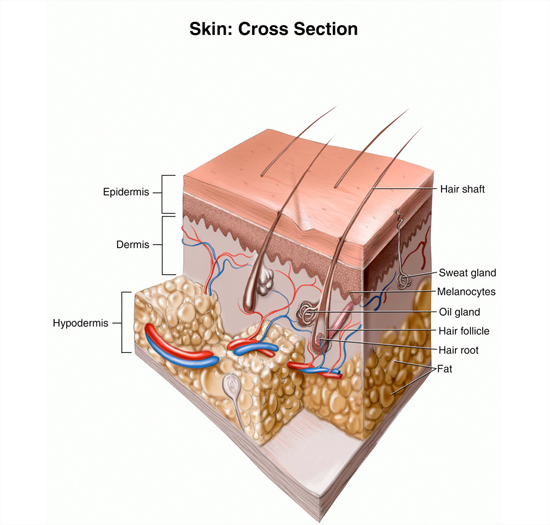Boils and Carbuncles
What are boils and carbuncles?
A boil is a type of infected sore on the skin. The sore is raised, red, painful, and filled with pus. A carbuncle is a large severe boil or group of boils that develop close together from spread of the infection.
How do they occur?
Boils commonly develop because bacteria have infected hair follicles, which are the small openings that hair grows from.
Staphylococcus aureus ("staph") is the name of the bacteria that usually infect hair follicles. The bacteria normally live on the skin, particularly on certain parts of the body, such as the nose, mouth, genitals, and rectum. The bacteria cause an infection only if they enter the skin through a scrape, irritation, or injury of some kind. Sometimes friction on the skin--from clothing, for example--will cause a hair follicle to swell up. This can make the opening close up, trapping the bacteria inside and starting an infection.
Boils and carbuncles often form in moist areas of the body such as the back of the neck, buttocks, thighs, groin, and armpits.
If you have a chronic illness, such as diabetes or kidney or liver disease, you may be more likely to have boils and carbuncles.
What are the symptoms?
A boil starts out as a red lump. Usually within 24 hours, the lump fills with pus and looks round with a yellow-white tip. Pus or other fluid may drain from the boil. There may be swelling around the boil. The boil may hurt only when you touch it or it may be quite painful all of the time.
Lymph nodes near the boil may also swell. You are most likely to notice swollen lymph nodes in the neck, armpit, or groin area.
Symptoms of carbuncles are similar but more severe than the symptoms caused by boils.
How are they diagnosed?
Your healthcare provider will examine the infected area. Tell your provider if you have had a boil or carbuncle longer than 2 weeks or if you have boils often.
If you have boils often, you may have lab tests of your blood or urine. These tests can check for conditions that might make you more likely to have the sores, such as diabetes or kidney or liver disease.
How is it treated?
A boil can sometimes be treated at home, but a carbuncle often needs medical treatment.
For treatment at home you can:
- Wash your hands and then put a warm, moist cloth on the boil or carbuncle for 10 to 15 minutes at least 3 times a day. This helps the boil come to a head and drain on its own--the safe way to drain. Once the boil begins to drain, you will have less pressure and pain.
- If the boil or carbuncle is in your groin or on your buttock you can soak in a tub of warm water for 10 to 15 minutes. Be sure to clean the tub well before and after soaking so that bacteria cannot be passed to others.
- After soaking or using the moist cloth, clean the skin around the sore with water and antibacterial soap. Put a sterile gauze bandage over the area until it is healed. If drainage soaks through the bandage or the bandage gets wet or dirty, change it as soon as possible.
- Take a pain reliever, such as acetaminophen.
These steps will help relieve the pain, reduce the risk of spreading the infection, and help boils to heal.
Your healthcare provider may recommend that you take antibiotic drugs to heal the infection. Your provider may drain the boil or carbuncle by opening it with a sterile needle or scalpel. After the sore has been opened, it should be covered with a loose, gauze dressing until it heals. Do not try to open a boil at home. Opening a boil at home may cause spread of the infection into the bloodstream and cause serious medical problems.
If you have an underlying illness, such as diabetes, your healthcare provider will want you to schedule follow-up appointments so your condition can be monitored. If your boil or carbuncle does not heal properly or if new symptoms develop, contact your provider.
How long will the effects last?
Boils may take from 1 to 3 weeks to heal. In most cases, a boil will not heal until it opens and drains. This can take up to a week.
A carbuncle often requires treatment by your healthcare provider. Depending on the severity of the problem and its treatment, the carbuncle should heal in 2 to 3 weeks after treatment.
Your healthcare provider may want to see you for a follow-up visit if he or she prescribes medicine to treat the infection, such as antibiotics, or treats it by opening the boil.
How can I take care of myself?
Be sure to follow the instructions your healthcare provider gives you. Take any prescribed medicine as directed.
Call your healthcare provider if:
- You have signs that the infection is getting worse. These include:
- The skin is becoming redder or more painful.
- You have red streaks from the affected area going toward your heart.
- The wound area feels very warm when your touch it.
- You have pus or other fluid coming from the wound area.
- You have a fever higher than 101.5° F (38.6° C).
- You start to have chills, nausea, vomiting, headache, or muscle aches.
- A boil does not drain on its own or heal with treatment at home.
- The boil lasts longer than 1 week.
- The boil becomes very large or painful.
- You are an adult over the age of 65.
- You have diabetes or another chronic health problem, such as kidney or liver disease.
- You have a boil on your face, especially if it is near your eyes or nose.
- You have a cluster of boils.
- You are getting boils often.
What can I do to help prevent boils and carbuncles?
To help prevent boils and carbuncles from spreading and coming back:
- Do not open or squeeze the boil or carbuncle yourself. This can spread the infection.
- If the boil opens or drains, clean it with an antiseptic soap. Cover it with a loose, gauze bandage. Change the bandage at least every day until the boil stops draining.
- Wash your hands often with soap for at least 15 seconds. Always wash your hands after caring for the boil, after using the bathroom, and especially before touching any food. (The bacteria that cause boils can also cause food poisoning.) You can also carry an alcohol-based hand cleaner to clean your hands when soap and water aren't available.
- Wash clothes that touch the infected area in hot, soapy water. Dry clothes on the hot setting if you use an automatic dryer.
- Practice good personal hygiene. Bathe or shower daily.
- Don't share washcloths, towels, clothing, bath water, or razors. Sharing these items could spread the infection to others. Wash your hands well after caring for the boil.
- Get treatment for any underlying illness or skin problem.
Developed by RelayHealth.
Published by RelayHealth.
This content is reviewed periodically and is subject to change as new health information becomes available. The information is intended to inform and educate and is not a replacement for medical evaluation, advice, diagnosis or treatment by a healthcare professional.
© 2018 RelayHealth and/or its affiliates. All Rights Reserved.
Acne
Allergies (Seasonal)
Antibiotics
Asthma
Attention Deficit/Hyperactivity Disorder (ADHD)
Anxiety
Bacterial Vaginosis
Back Pain
Bed Bugs
Boils and Carbuncles
Chickenpox
Chlamydia
Cold Sores/Fever Blisters
Constipation
Contact Dermatitis
Contact Lens and Eye Care
Common Cold
Corneal Abrasion
Crab Lice
Cyclospora - foodborne illnesses and washing fresh produce
Deep Vein Thrombosis
Diarrhea
Depression
Diabetes
Dizziness
Do I Have a Problem with Alcohol or Drugs
Eating Disorders
Ebola Facts
Eczema
Fibrocystic Breasts
Flu on Campus
Food Allergies and Intolerances
Gastroenteritis
Genital Warts
Gonorrhea
Headache
Heartburn
Hemorrhoids
Hepatitis A
Hepatitis B
Hepatitis C
Herpes
Herpes Zoster (Shingles)
High Blood Pressure (Hypertention)
HIV
HPV
Hypoglycemia
Hypothyroidism
Impetigo
Influenza
Inhaler Instructions
Insomnia
Iron Deficiency Anemia
Irritable Bowel Syndrome
Is it allergies, a cold, or the flu
Jock Itch
Measles (Rubeola)
Meningitis
Menstrual Cramps
Migraine Headaches
Monkeypox
Mononucleosis
Information About Mumps
Pelvic Inflammatory Disease
Pertussis
Pink Eye
Pilonidal Cyst
Pityriasis Rosea
Scabies
Sexually Transmitted Infections (STIs)
Sore Throat
STI/HIV Testing
Syphilis
Tinea Corporis (Ringworm)
Tinea Pedis (Athlete's Foot)
Tinea Versicolor
Trichomoniasis
Tuberculosis (TB)
Upper Respiratory Infections – Self-Care
Urinary Tract Infection - Men
Urinary Tract Infection-Women
Warts
West Nile Virus
Yeast Infection
Zika Virus
Alcohol & Athletic Performance
Alcohol & Drugs Counseling Programs
Alcohol & Drugs Individual Consultation
Alcohol Rules and Laws
Alcohol & Study Abroad
Alcohol Overdose and the Bacchus Maneuver
Brief Alcohol Screening & Intervention for College Students (BASICS)
Binge Drinking
Blood Alcohol Concentration (BAC)
Bruce the Bat
Getting Home Safe
Hangover
Having Fun and Playing it Safe (AOD)
How to Help a Friend (Alcohol and Drug Concerns)
Individual Consultations: Alcohol & Other Drugs
K2 - Synthetic Marijuana
Marijuana
Mixing Alcohol and Energy Drinks
Naloxone / Narcan
Party Drugs and Predatory Drugs
Prescription Drug Misuse
Prescription Stimulant Misuse
Smoking, Tobacco, and Nicotine
Steroids
Student Amnesty for Alcohol Emergencies
Vaping (E-cigarettes), Smokeless Tobacco, Hookah
Workshops on Alcohol & Other Drugs
Consultations with a Registered Dietitian
DASH Diet
Diabetes
Dry Skin
Eating Disorders
Food Allergies and Intolerances
Food and Mood (PDF)
Fuel for Your Brain (PDF)
Heart Health
High Blood Pressure (Hypertention)
Hydration
Hypoglycemia
Meal Planning
Mindful Eating Program
Mixing Alcohol and Energy Drinks
Normal Intuitive Eating
Nutrition Videos
Peer Led Nutrition Workshops
Sample Menu (PDF)
Snacks to Go
Tips for Gaining Weight (PDF)
Tips for Losing Weight (PDF)
Vegetarianism
What About Supplements (PDF)
Annual Wellness Exam
Bacterial Vaginosis
Breast Exam
Chlamydia
Colposcopy
Condoms
Get Free or Low-Cost Condoms
Contraception
Crab Lice
Dating Relationship Violence
Depo-Provera
Diaphragm
Emergency Contraception
Erectile Dysfunction
Fibrocystic Breasts
Genital Warts
Gonorrhea
Healthy Relationships
Healthy Sexuality Workshops
Hepatitis A
Hepatitis B
Hepatitis C
Herpes
HIV
HPV
Intrauterine Device (IUD)
Lube
Men's Sexual Health
Menstrual Cramps
Nexplanon
Nuvaring
Partner Notification and Treatment Information for Gonorrhea
Partner Notification and Treatment Information for Chlamydia
Pelvic Inflammatory Disease
Healthyhorns Play Safe
Pregnancy
Premenstrual Syndrome
Relationships: Fighting Fair
Romantic Relationships: Building a Healthy Relationship
Scabies
Sexually Transmitted Infections (STIs)
Sexual Violence (Rape and Sexual Assault)
Sexual Assault Forensic Exams at UHS
Sponge
STI Testing at UHS
STI/HIV Testing
Surviving a Breakup
Syphilis
Testicular Exam
Truvada
Trichomoniasis
Urinary Tract Infection - Men
Urinary Tract Infection-Women
Yeast Infection
Ankle Exercies (PDF)
Ankle Sprain
Bacchus Manuever
Back Pain
Binge Drinking
Bites: Animal and Human
Bites and Stings
Body Art Safety - Piercing
Body Art Safety - Tattoos
Burns
Cast/Splint Care (PDF)
Cuts and Scrapes
Head Trauma
Heat Exhaustion and Heat Stroke
Medical Emergencies
Poison Ivy, Oak and Sumac
Scooter Safety
Sprains and Strains
Sunburn and Sun Safety
Wound Care Instruction Sheet (PDF)
Alcohol and Drugs
Alcohol and Drugs Individual Consultation
Anxiety
Assertiveness
Attention Deficit/Hyperactivity Disorder (ADHD)
Behavior Concerns and COVID-19 Advice Line (BCCAL)
Body Image
Building Friendships
Dating and Relationship Violence
Depression
Eating Disorders
Problem and Compulsive Gambling
Grief and Loss
Insomnia
Medication for Depression
Mindful Eating Team
Napping
Normal Intuitive Eating
Perfectionism
Problematic Internet Use
Sexual Violence (Rape and Sexual Assault)
Relationships: Fighting Fair
Romantic Relationships: Building a Healthy Relationship
Self Esteem
Sleep
Stalking
Stress
Suicide Prevention
Veterans: Making the Transition to UT
▼
 Safety
Safety
Bacchus Manueuver
Behavior Concerns and COVID-19 Advice Line (BCCAL)
Binge Drinking
Blood Alcohol Concentration
Campus Security and Safety
UT Police Department
Dating and Relationship Violence
Getting Home Safe
Medical Emergencies
Mixing Alcohol and Energy Drinks
Party Drugs
Preparedness Central
Rape Aggression Defense System (RAD) Classes
Scooter Safety
Sexual Violence (Rape and Sexual Assault)
Spring Break Safety Tips
Stalking
SURE Walk Program
UT Environmental Health and Safety
▼
 Skin
Skin
Acne
Bites: Animal and Human
Bites and Stings
Body Art Safety - Piercing
Body Art Safety - Tatoos
Boils and Carbuncles
Burns
Cold Sores/Fever Blisters
Contact Dermatitis
Cuts and Scrapes
Ear Wax
Eczema
Hives
Herpes
Herpes Zoster (Shingles)
HPV
Impetigo
Jock Itch
Pilonidal Cyst
Pityriasis Rosea
Poison Ivy, Oak and Sumac
Scabies
Skin Cancer
Skin Exam
Sunburn and Sun Safety
Tinea Corporis (Ringworm)
Tinea Pedis (Athlete's Foot)
Tinea Versicolor
Warts
Alcohol and Drugs
Alcohol Workshops
Body Image
Breast Exam
Bystander Intervention
Cold & Flu Prevention
Condoms
Cultural Adjustment, A Guide for International Students
Exercise
Getting Home Safe
Hand Washing
Health & Academic Performance
Healthy Relationships
Healthyhorns Peer Educators
Healthyhorns Play Safe
Heart Health
How to Help a Friend (Alcohol & Drugs)
Hydration
Immunization
Love Your Body
Napping
National College Health Assessment (NCHA)
Resident Assistants Resources
Self Esteem
Sex (Healthy Sexuality)
Sleep
Spring Break Safety Tips
Stress
Student Health Insurance
Suicide Prevention
Testicular Exam
Veterans: Making the Transition to UT


